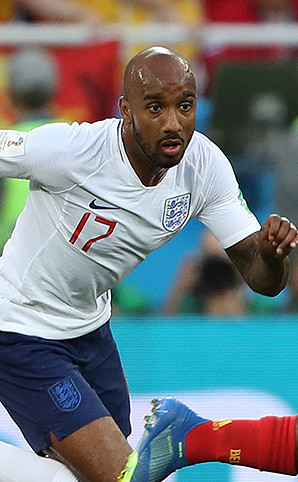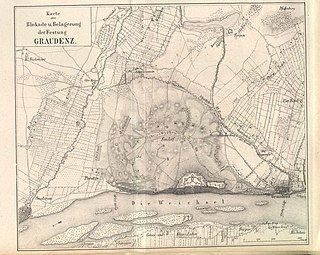Related Research Articles

The Marienwerder Region was a government region (Regierungsbezirk) of Prussia from 1815 until 1920 and again 1939-1945. It was a part of the Province of West Prussia from 1815 to 1829, and again 1878–1920, belonging to the Province of Prussia in the intervening years, and to the Reichsgau Danzig-West Prussia in the years 1939-1945. The regional capital was Marienwerder in West Prussia.

Grudziądz is a city in northern Poland, with 92,552 inhabitants (2021). Located on the Vistula River, it lies within the Kuyavian-Pomeranian Voivodeship and is the fourth-largest city in its province. The Old Town of Grudziądz and 14th-century granaries were declared National Historic Monuments of Poland.

Fabian Ernst is a German former professional footballer who played as a midfielder. He was regarded as a two-way player who can stop the opposition and start attacks with his passing from central midfield.
Fabián Alberto O'Neill Domínguez was a Uruguayan professional footballer who played as a midfielder.

Fabián Raphael Estay Silva is a Chilean former professional footballer who played as a midfielder.

Fabian Delph is an English former professional footballer who played as a central midfielder or left-back.

Marco Jhonfai Fabián de la Mora is a Mexican professional footballer who plays as an attacking midfielder for Rànger's. He is an Olympic gold medalist.

The Graudenz class of light cruisers was a class of two ships built for the Imperial German Navy. The class comprised SMS Graudenz and SMS Regensburg. The ships both were laid down in 1912, launched in October 1913 and April 1914 and commissioned in August 1914 and January 1915, respectively. They were armed with a main battery of twelve 10.5 cm (4.1 in) guns, though over the course of their careers, they were rearmed with seven more powerful 15 cm (5.9 in) guns. They displaced 6,382 t at full load and were rated at a top speed of 27.5 knots

SMS Graudenz was the lead ship of her class of light cruisers. She had one sister ship, SMS Regensburg. The ship was built by the German Kaiserliche Marine in the Kaiserliche Werft shipyard in Kiel, laid down in 1912 and commissioned into the High Seas Fleet in August 1914, days after the outbreak of World War I. She was named for the then-German town of Graudenz. The ship was armed with a main battery of twelve 10.5 cm SK L/45 guns and had a top speed of 27.5 knots.
Fabian is the English form of the late Roman name Fabianus. This was a name originally given to those adopted into or descended through the female line from a Roman family named Fabius, that derived from the Latin faba for the broad bean, an important food crop in antiquity. It entered the English language with the Normans, but has never achieved the popularity of Fabien in France, Fabio or Fabiano in Italy and Portugal, and Fabián in Spain.
Uruguay national under-20 football team represents Uruguay in international football competitions such as FIFA U-20 World Cup and the South American Youth Football Championship. They are the current reigning FIFA U-20 World Champions.
Charles Fabian Figueiredo Santos is a Brazilian football manager and former player, who played as a striker.

Fabián Coito Machado is a Uruguayan football manager and former player who played as a defender.

Fabian Lukas Schär is a Swiss professional footballer who plays as a centre-back for Premier League club Newcastle United and the Switzerland national team. He is known for his powerful free kicks, long shots and long passes.

Fabián Ruiz Peña, also known simply as Fabián, is a Spanish professional footballer who plays as a central midfielder for Ligue 1 club Paris Saint-Germain and the Spain national team.
The 142nd Rifle Division began service in August 1939 as a standard Red Army rifle division, which participated in the Winter War against Finland. It remained on the Karelian Isthmus and had a relatively uneventful war facing the Finns until the Vyborg–Petrozavodsk Offensive began on June 10, 1944, from which point it saw much more active service. Following the end of the Continuation War, the division was transferred to 2nd Shock Army in 2nd Belorussian Front. Its soldiers distinguished themselves in the capture of the German city of Graudenz and ended the war fighting through Pomerania.

Wolfgang Kreher Johannes "John" Graudenz was a German journalist, press photographer, industrial representative and resistance fighter against the Nazi regime. Graudenz was most notable for being an important member of the Berlin-based anti-fascist resistance group that would later be named by the Gestapo as the Red Orchestra and was responsible for the technical aspect of the production of leaflets and pamphlets that the group produced.

Wilhelm René de l'Homme de Courbière was a Prussian field marshal who served in several wars of the 18th century and during the Napoleonic Wars. Stemming from a French Huguenot family; he notably held the fortress of Graudenz against Napoleon's troops throughout 1807, long past the Peace of Tilsit, until the siege was finally lifted after 11 months.

The siege of Graudenz or siege of Grudziądz was a siege during the Napoleonic Wars between 22 January and 11 December, 1807. As part of the War of the Fourth Coalition the Prussian fortress at Graudenz in West Prussia in the Prussian Partition of Poland was besieged by forces of the French Empire and its allies. The garrison, commanded by General Wilhelm René de l'Homme de Courbière, withheld blockade and siege for some 11 months, long past the formal Peace of Tilsit. The French abandoned the siege after the borders between Prussia and the new Duchy of Warsaw were defined; Graudenz/Grudziądz staying a Prussian possession until Poland regained independence after World War I.
Anna Krauss was a German clairvoyant, fortune-teller and businesswomen who became a resistance fighter against the Nazi regime, through her association with a Berlin-based anti-fascist resistance group that was later called the Red Orchestra by the Abwehr, during the Nazi regime.
References
- ↑ Fabian Graudenz at WorldFootball.net
